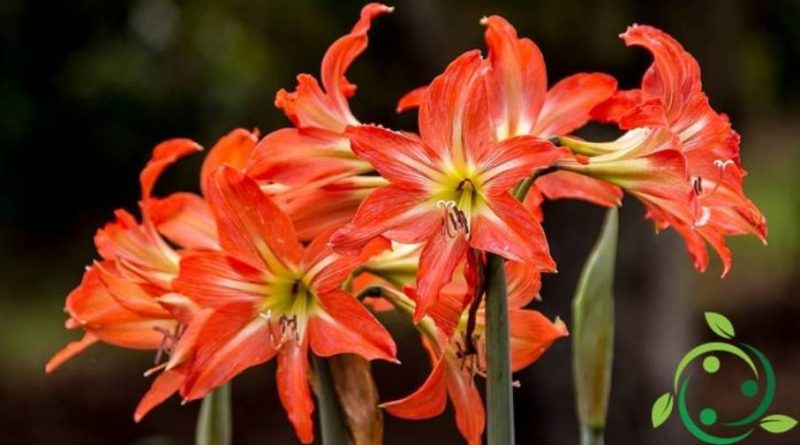How to grow Hippeastrum
How to grow Hippeastrum
To the genus Hippeastrum Herb., Of the family of the Amaryllidaceae and originating in South America, belong over 90 evergreen bulbous species or with deciduous summer foliage, with large spherical bulbs from which thick and fleshy roots depart.
Among the most known species we remember the Hippeastrum vittatum, originating from Ecuador and Peru, with deciduous leaves and flowers with variable colors, from which a large number of widely cultivated hybrids are derived, the Hippeastrum aulicum, originating from southern Brazil, species which in southern areas it blooms in winter with vegetative rest in the warm season, Hippeastrum papilio, a native of Brazil, an evergreen plant with spring bloom, Hippeastrum reginae, a historic hybrid resistant to low temperatures, (-7 ° C), the Hippeastrum × johnsonii.
In this card we will see how to grow Hippeastrum following the most suitable agronomic tricks for these plants.
The Hippeastrums are characterized by 3 – 7 long leaves from 10 to 60 cm and 1 or 2 floral stems, which generally carry from 2 to 6 large funnel-shaped flowers and with various colors ranging from red, pink, orange, salmon, streaked white and , only in some hybrids, yellow and rarely perfumed.
Hippeastrum can be grown both in pots, on terraces or in apartments and in open ground and is also cultivated for the commercial production of cut flowers. For outdoor cultivation it is necessary to be in a hot climate, with generally spring flowering.
Instead, in annual cultivation, excellent flowering is obtained.
In this case the bulbs should be placed in medium-large pots, around November, positioning them so that they remain 3 cm between the bulb and the wall of the vase.
The substrate to be chosen or prepared must consist of leaf mold, silica sand, earth and mature manure or organic substance in identical proportions.
The pots should be placed in areas that are quite bright but not in direct sunlight, with ambient temperatures around 25 ° C.
As far as irrigation is concerned, these should be done when the plants begin to vegetate, then adjusting with the interventions only when the first layers of the soil begin to dry.
Once arrived at flowering it is good to decrease the temperature of the room or, in the impossibility, transfer the plant to a lower temperature environment to facilitate a longer lasting flowering.
The vegetative cycle of the Hippeastrum continues also, for a certain time, after the flowering is completed, to subsequently enter the phase of vegetative rest.
This moment is highlighted with the end of leaf growth. At this point the irrigations must be delayed over time to finish them when the leaves begin to dry and fall.
At the end of the vegetal rest period the leaves left about 10 cm from the collar should be cut, so as to be able to favor the new blooms.
Furthermore, at the end of the cycle, the plant will have produced new bulbs that can be separated to reproduce new plants. The new bulbs, to be placed always in November, will produce inflorescences only after 3-6 years, a period that will be used by the plant to accumulate the substances in the bulbs and to produce inflorescences of optimal size.
It is emphasized that the Hippeastrum can also be reproduced by seed to be planted in the spring in a heated greenhouse; in this case, however, you have to wait 3 years to get the first flowering.
In Italy there are few areas where it can remain in the open ground during the whole year. Very suitable for the Italian climate are the Hippeastrums of the “Sonatini” type. These are species that can remain buried for several years in the garden. In the open ground the bulbs should be planted in a rich and permeable substrate. Particular attention should be paid to roots that must not be damaged in any way. Before planting it is advisable to soak the roots in warm water for a few hours. The bulb must be covered by the soil so that the collar remains above the level of the earth. If you plant more bulbs and if you intend to leave them for several years in the same place, it is advisable to space them out to make room for the enlargements of the bulbs themselves.
It is essential to know the climatic conditions of the cultivation area. Since the winter temperature should not fall below 5 – 7 degrees, it is advisable to avoid places where frosts occur. For the protection of the collar an abundant vegetable mulch is advisable. It is also essential to avoid water stagnation. Too much moisture can cause serious damage to the roots.
Growth occurs at an ambient temperature above 16 ° C and with higher temperatures it accelerates considerably. If the precipitations are not enough to keep the soil slightly humid with the growth of the scape, waterings must be increased. When the plant reaches 15 cm you can proceed with fertilizing with a fertilizer for flowering plants.
It is essential that the plants are placed in a place where they can receive at least a few hours of sunshine, preferably in the morning. When there is flowering it is advisable to ensure shading at least during the hottest hours. The withered flowers must be removed by cutting them under the ovary.

